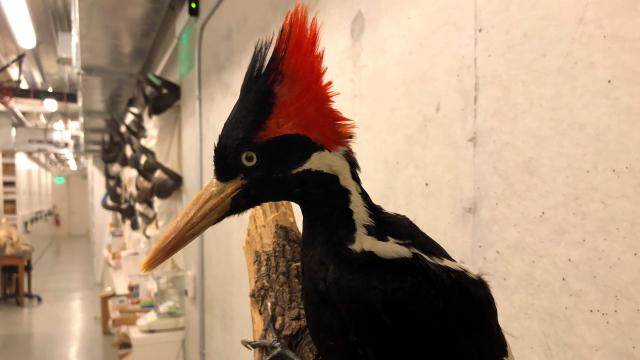The U.S. Fish and Wildlife Service will propose removing 22 animals and one plant from the endangered species list on Wednesday, declaring them extinct. The casualties — 11 birds, eight species of freshwater mussels, two fish, one bat, and a flower — are victims of the climate crisis and habitat degradation. It’s a sign of the extinction crisis, one that will worsen if humans don’t get their act together.
Among the species we’ve lost is the well-known ivory-billed woodpecker, a gorgeous, black-and-white feathered bird with a scarlet crest on its head. It has not been seen since 2004, though birdwatchers have prowled Arkansas hardwood forests for the 17 years since that last sighting. Also on the list is the Bachman’s warbler, a migrating bird that used to spend spring in the floodplain forests of South Florida and southeastern Louisiana, and the scioto madtom, a long, golden fish once abundant in Ohio. The creatures join the dreaded list of 650 American species that wildlife officials have declared lost to extinction as well as a growing list globally.
Craig Hilton-Taylor, an official at the International Union for Conservation of Nature, the world’s leading authority on the status of wildlife, told the AP that prematurely declaring defeat can be harmful.
“Suddenly the (conservation) money is no longer there, and then suddenly you do drive it to extinction because you stop investing in it,” he said. Roughly half of the species on the new extinction list are already considered extinct by the International Union for Conservation of Nature, but others, including the ivory-billed woodpecker, are not.
Many of the 23 new additions were already in peril when the U.S. passed the Endangered Species Act in 1973. The scioto madtom, for instance, hasn’t been seen since 1957. And while losing some species is obviously heartbreaking, the act has largely been a success.
“The Endangered Species Act has prevented the extinction of 99% of the plants and animals under its care, but sadly these species were extinct or nearly gone when they were listed,” said Tierra Curry, a senior scientist at the Centre for Biological Diversity, in an emailed statement.
The loss of these 23 species, though, is a sign of the need for quicker and more robust action to protect vulnerable wildlife. Advocates have long pressured the Fish and Wildlife Service to act more quickly to protect species. Currently, in order to be protected under the Endangered Species Act, species must first be listed as threatened or endangered. A 2016 study found that officials wait a median of 12 years after giving a species one of those designations to actually provide safeguards, and dozens of species have disappeared while languishing in legal limbo. Some of the species in today’s announcement — including the Guam broadbill, little Mariana fruit bat, and three kinds of mussels — went extinct during a delay in that listing process, according to the Centre for Biological Diversity.
“We can’t let bureaucratic delays cause more extinctions,” said Curry.
Another issue is a lack of funding for protections. Another 2016 report found that Congress only provides approximately 3.5% of the funding that the Fish and Wildlife Service has said is needed to bring endangered plant and animal species back from the brink. The trend of underfunding conservation is persistent. President Biden requested a $US60 ($83) million increase for endangered species protection this year, yet the House Appropriations Committee shortchanged the request by $US17 ($24) million. Two bills that Congress is currently considering, the Extinction Prevention Act and the Extinction Crisis Emergency Act, would provide additional federal dollars for conservation.
Endangered Species Act success stories are also at risk of turning into a nightmare due to state actions. The wolves reintroduced to Yellowstone National Park in the mid-1990s are most well-known example of the act’s power to bring species back to healthy populations. But right-wing governments in the states around Yellowstone are now threatening to undermine that wolf recovery, with Montana’s governor even going so far as to kill a Yellowstone wolf himself.
There are also much bigger pressures that could further imperil the natural world. A major 2019 report found that up to 1 million species could go extinct in the next few decades — or one-eighth of all species of plants and animals on Earth — thanks to land degradation, the climate crisis, and other factors. But crucially, that report also said that with stronger environmental protection laws, better natural systems management, and global cooperation towards climate and conservation goals, that doesn’t have to be our fate.
“Extinction is not inevitable. It is a political choice. Saving species isn’t rocket science. As a country we need to stand up and say we aren’t going to lose any more species to extinction,” said Curry.
